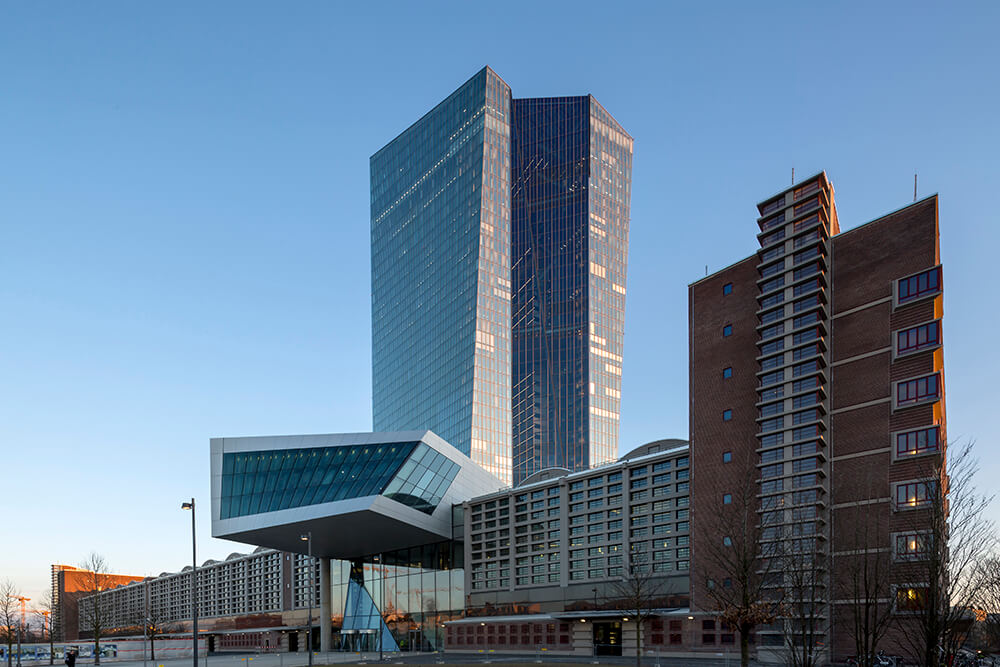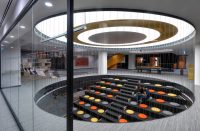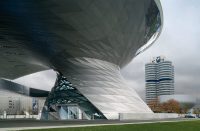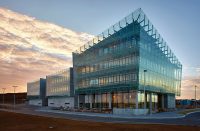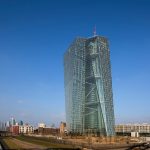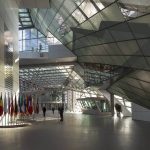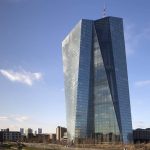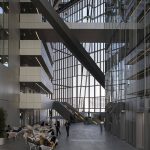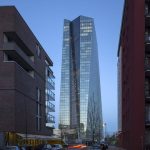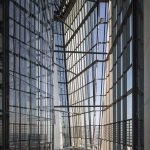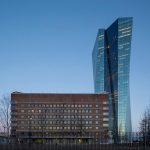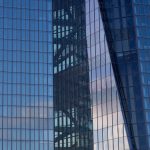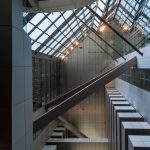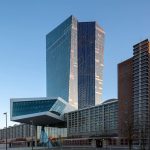Architect(s): Coop Himmelb(l)au
Address: Sonnemannstraße 20, FRANKFURT, Germany
Latitude/Longitude: 50.109003,8.703772
Photographs: Paul Raftery
The new premises of the European Central Bank in Frankfurt were contructed from a design which combines the horizontal structure of the landmarked Grossmarkthalle with a twisted double tower, rising to 185 meters, from the Viennese architectural studio Coop Himmelb(l)au. United by an entrance building, these two elements form An ensemble of special architectural significance is formed from these two elements, united by an entrance building. A vertical city is created with featuring bridges, pathways, and platforms, the glass atrium between the two highrises. The former Grossmarkthalle has the semi-public and communicative functions. The ECB building belongs to an entirely new typology of skyscrapers, a noticeable fact by the exceptional atrium and visible steel support structure show that.
The hyperboloid cut
From the beginning, it was an explicit request of the ECB to create a unique, iconic building as a symbol of the European Union. A distinctive and unique building can only be achieved by a completely different kind of Geometry.
The vertical division of a monolithic block through a hyperboloid cut, wedge it apart, twist it and fill the newly created intermediary space with a glass atrium is the design concept of the ECB. The result is a very complex geometry and a multifaceted building offering a completely different appearance from each angle: massive and powerful from the South-East, slender and dynamic from the West.
The principle of the “Vertical City”
Three sections with heights from 45 to 60 meters come out from the division of the atrium horizontally by the connecting and transitioning platforms. This is where all vertical entry points are joined – and just like public squares, they invite visitors to communicate. A pleasant room climate is ensured with the planned hanging gardens while elevators and stairs connect these places with the offices and communication areas of the Grossmarkthalle.
The Grossmarkthalle – the communicative forum
An urban foyer is created with the former wholesale market from the 1920s, the existing landmarked Grossmarkthalle. Some of the areas are placed diagonally in the spacious interior of the hall as independent building structures, using a “house within a house” concept, like the conference and visitor’s center, library and employee cafeteria. The hall structure is penetrated from the outside with a floating entrance building. The representative access to the ECB is marked with the building’s asymmetrical contours, slanted facades and generous windows. In this area, one can find the lobby, two-story press conference room, and a lecture room. The ensemble is completed with the loop, a glass walkway between the high rise and the market hall.
The sustainable energy concept
Energy efficiency and sustainability were key factors in the competition. The energy concept includes the following measures: utilization of rain water, heat recovery, efficient insulation, sun protection and illumination as well as a natural ventilation for the offices. Some areas, such as the atrium and open zones of the Grossmarkthalle, are not equipped with an air conditioning system; instead, they serve as a buffer zone between the interior and exterior climates. Three layers make out the shield hybrid facade of the building which offers a direct and natural ventilation of the offices via vertical, room-high ventilation elements.
Urban construction and architecture
The ECB’s architecture was carefully attuned to its location in Frankfurt’s Ostend district. A dialogue with Frankfurt’s most important reference points is entered through the ensemble that has a clear orientation towards the urban perspectives. These points are the Alte Oper, the Museum Embankment and the skyline of the financial district. All of the important places in Frankfurt’s city center and the Main river have a view on the distinctive double tower which creates an initial point for a second center in the East of Frankfurt.
Wolf D. Prix, Design Principal, and CEO of Coop Himmelb(l)au says that this function of the tower is able to correspond to the principle of a polycentric city. “Tension areas begin to emerge between the centers, in which New developments are being provoked in the centers and, between them, tension areas begin to emerge.”
Hessian Culture Prize
Wolf D. Prix received the prestigious Hessian Culture Prize for the design of the new premises of the European Central Bank in November 2013. Since 1982, this award has been given annually for special accomplishments in the areas of art, science and cultural mediation. “With the new premises of the European Central Bank, Coop Himmelb(l)au is creating a new, modern landmark for Frankfurt,” the eleven-member Board of Trustees said in a statement about the award.
Text description provided by the architects.
Contributed by Coop Himmelb(l)au

